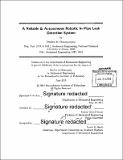A reliable & autonomous robotic in-pipe leak detection system
Author(s)
Chatzigeorgiou, Dimitris M
DownloadFull printable version (22.98Mb)
Alternative title
Reliable and autonomous robotic in-pipe leak detection system
Other Contributors
Massachusetts Institute of Technology. Department of Mechanical Engineering.
Advisor
Kamal Youcef-Toumi.
Terms of use
Metadata
Show full item recordAbstract
Leaks are the major factor for unaccounted losses in every pipe network around the world (oil, gas or water). In most cases the deleterious effects associated with the occurrence of leaks may present serious economical and health problems. Therefore, leaks must be quickly detected, located and repaired. Unfortunately, most state-of-the-art leak detection systems are of limited applicability, lack in reliability or depend on user experience for data interpretation. In this dissertation we present a new, autonomous, in-pipe, leak sensing system; the "MIT Leak Detector". The proposed system is able to perform autonomous leak detection in pipes and, thus, eliminates the need for user experience. In addition, the sensing methodology under consideration is independent of pipe material and surrounding medium, thus it is widely applicable. As shown in the experimental section of the thesis, the detection principle proves to be very reliable and sensitive to small leaks in pipes. Last but not least, the robotic system is equipped with intelligence in order to use the acquired sensor signals to estimate the leak size and flow rate without user intervention. We start the thesis by describing the fundamental concept behind detection and present the proposed design. The detection principle in based on the presence of a pressure gradient in the neighborhood of any leak in a pressurized pipe. This phenomenon is translated into force measurements via a carefully designed and instrumented mechanical embodiment. In addition, an analytic dynamic model of the robotic detector is derived. Further study and analysis show that the proposed system can sense leaks at any angle around the circumference of the pipe by utilizing two force measurements at specific locations. Finally, a prototype is built and experiments are conducted in controlled laboratory conditions in compressed air pipes.
Description
Thesis: Ph. D., Massachusetts Institute of Technology, Department of Mechanical Engineering, 2015. Cataloged from PDF version of thesis. Includes bibliographical references (pages 145-151).
Date issued
2015Department
Massachusetts Institute of Technology. Department of Mechanical EngineeringPublisher
Massachusetts Institute of Technology
Keywords
Mechanical Engineering.